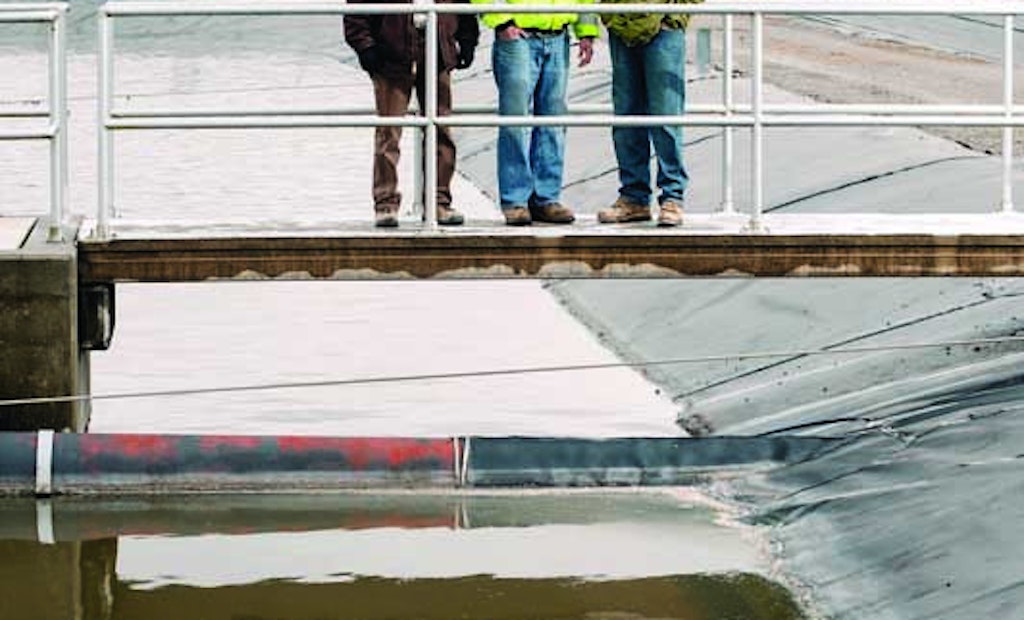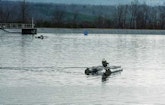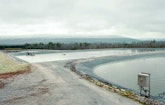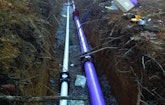
Interested in Alarms/Controls?
Get Alarms/Controls articles, news and videos right in your inbox! Sign up now.
Alarms/Controls + Get AlertsThe Fairfield Glade Community Club development is certainly big enough for a wastewater treatment plant with a conventional stream discharge. The trouble is that the resort community and its 4,950 homes and 400 timeshare units lie in the watershed of the Obed Wild and Scenic River. Creeks in the area flow to the Obed, and the Tennessee Department of Environmental Conservation (TDEC) won’t allow discharge to them.
So Fairfield Glade developers turned to the soil. An extensive facultative lagoon series feeds a spray irrigation system and, more recently, a drip dispersal system cut into some 30 acres of forested land. The new drip system enables superior control of effluent dispersal and requires less maintenance than the spray system. Therefore, drip is the method of choice as the development grows toward its ultimate build-out at 18,200 housing lots.
Outgrowing the old
Fairfield Glade, with its multiple amenities including lakes and golf courses, lies between Knoxville and Nashville, within the city limits of Crossville. Since development began in 1970, the community has been served by a private water district and a private wastewater treatment system fed by gravity and low-pressure sewers.
The original treatment plant, about 7 miles from the southernmost point of the development, used an extended aeration process and discharged to a stream called Bagwell Branch. By 1995, that system had become obsolete and undersized, according to Bruce Evans, wastewater system superintendent for the community for the past four years. It was replaced in 2001 by the lagoon system with 2.9 mgd design capacity and 0.86 mgd average flow. Spray dispersal replaced stream discharge, which was no longer allowed under TDEC regulations.
“We’ve got a headworks that consists of an automatic fine screen (Vulcan Industries),” says Evans. “We have a complete-mix lagoon that contains 4.63 million gallons. From there the water flows to a first partial-mix lagoon of 17.5 million gallons, and then to a second partial-mix lagoon of 17 million gallons. Finally, it flows to a storage lagoon containing just over 4 million gallons.
“We have 350 acres inside the fence. The complete-mix lagoon does most of the work. That’s where most of the biological activity takes place and the CBOD and TSS are oxidized. We have created anoxic zones throughout the partial-mix lagoons by way of timers on our aerators (Jet Inc.).”
All told, the lagoons contain 19 Tornado Aspirating aerators (RWL Water, formerly Aeromix) that keep the contents mixed and oxygenated. “We nitrify in the complete-mix lagoon, and then through the anoxic zones we reduce the NO3, the nitrate, to nitrogen gas,” Evans says. “We’re required to monitor for NH3 (ammonia) and nitrate, and typically the combined concentration is less than 5 mg/L to the spray and dripfields.
“This plant was commissioned in 2001, and to date we have not had to remove any sludge at all. We have about 50 days of detention time. We operate under a state operating permit rather than an NPDES permit because we do slow-rate land treatment rather than stream discharge.”
Going to the land
Initially the lagoons fed only a spray irrigation system with 420 spray heads (Rain Bird) in six major zones and 23 subzones on a 78-acre field. The 850,000 gpd design capacity was based on a soil evaluation, but in practice that volume of effluent caused ponding and runoff. “We determined that the spray system could handle 650,000 gpd,” says Evans.
That left some 200,000 gpd in need of an alternate dispersal method, and that is where drip dispersal came in. Rutherford Utility Company of Murfreesboro and EcoStruct Group of Pleasant View jointly bid on and received the contract to build a drip system with 250,000 gpd capacity and telemetry controls. The design-build team also included SEC of Murfreesboro (design and engineering) and JNM Technologies of Bryan, Texas (computerized controls and drip dispersal equipment).
A drip dispersal system pumps effluent at low pressure through buried flexible plastic tubing in a dripfield. The tubing, containing evenly spaced emitters, distributes effluent uniformly through the field at a rate within the soil’s capacity to absorb it. The technology was developed for large agricultural irrigation projects and has been widely used with wastewater applications such as small commercial and housing clusters. Over the last decade, drip dispersal has gained acceptance in municipal projects.
The Fairfield Glade drip system uses 250,000 feet of 0.61-inch-inside-diameter drip tubing (Netafim USA) buried 8 to 10 inches deep, with emitters spaced 2 feet apart. A 60 hp Deming five-stage vertical turbine pump (Crane Pumps & Systems) sends water from the storage lagoon to a basket strainer and then to an Arkal Filtration Spin-Klin 100-micron self-cleaning disc filter (Amiad USA) that removes TSS and prevents clogging of the drip emitters. From there the water passes through a Netafim-ARAD Hydrometer flowmeter and a 6-inch force main to the dripfield.
The field consists of four main zones, each with eight subzones, individually controlled for fine regulation of effluent distribution. Each zone has a supply line and a flush line for periodically cleaning the emitter tubing.
Topographic challenges
Dripfield installation was a challenge because of uneven terrain and a TDEC mandate to install the tubing in the woods as much as possible.
“Most of the soil was sandy loam, but in some areas sandstone rock was a restricting layer,” says Glenn Marcum, owner of EcoStruct. “One of our big challenges was to do selective clearing of trees. Trees are your friend with drip irrigation because they provide substantial transpiration and evapotranspiration. So we wanted to leave as many big trees as possible, yet we had to be able to get in and plow the driplines in on contours. So there was a lot of clearing to do, and the terrain included slopes anywhere from 0 to 5 percent to 45 and 50 percent. We tried to stay under 30 percent slope.”
A soil evaluation undertaken by McGill Associates identified the soils with the most favorable loading rates. “We chose the best soils and used them with a blanket loading rate,” Marcum says. “If we encountered a soil that had clay or shallow depth to rock, we considered that a restrictive soil, and that was a soil we did not use.”
Exerting control
Today, both the spray irrigation and drip dispersal fields are computer-controlled, although the dripfield control is more automated. The user-programmable system includes a PC that runs ICC software (Motorola). “I can go in and change the program as needed,” says Evans.
The program communicates wirelessly to a programmable logic controller which in turn communicates wirelessly to five slave panels, four for the drip system and one for the spray. Each slave panel includes an IRRInet irrigation control panel (Motorola). Flow to each spray or drip zone is regulated by a hydraulic valve opened and closed by way of a 12-volt batching solenoid, which receives its commands by way of a solar-powered IRRInet-M remote telemetry unit.
Before the computerized controls were installed, Evans or a team member had to manually open and close 10- or 12-inch valves in the sprayfield based on site conditions. “I used to do it every day, multiple times per day,” Evans says. “Now it’s simply with a click of a mouse or a text from my phone. It makes life a whole lot easier. Under our permit, we’re required to inspect the sprayfield once a week, but I go out there five to seven times a day.”
Dispersal made easier
The drip dispersal field, now handling about 200,000 gpd, requires much less manual attention. “It’s simply a land application process where we know we want to disperse an amount of water, we have so many acres on which to do it and we have a specific soil loading rate we want to use,” says Marcum. “We divided it out and calculated out how many minutes each zone would have to run each day to disperse up to 250,000 gallons.”
The zones operate on a rotating basis, 24 hours a day. Each major zone may contain three to four classifications of soils or depths to a restrictive layer. Evans observes, “Of the 32 subzones, we have no more than four dripping at any given time. We use a top-down method: We drip on the highest contour in all four major zones first and work our way down. Usually, it’s a 15-minute cycle per subzone. That’s based on an application rate of 0.21 gpd per square foot over 24 hours.”
Evans can evaluate zones over time and adjust the cycle time if a zone becomes too wet. Each subzone can be programmed for the cycle time that delivers the optimum amount of water. “I can inspect the dripfield once a week and it’s fine,” says Evans.
“The drip system started up in May 2013, and the results are fantastic. I’m looking forward to putting more drip in and slowly backing off on the spray. Spray is much more maintenance intensive, and it’s very weather-dependent. We have difficulty when it rains hard, and cold temperatures can cause freezing conditions. The drip system is not weather-dependent at all. As long as you keep up with the general maintenance, the equipment works perfectly.”
The community’s total 16,000 building sites include about 10,000 still available. About 100 new homes started construction in both 2013 and 2014, and building continues. That means growth ahead for the treatment plant and its drip irrigation system.
“We have another 100 acres set aside right across the road from the treatment plant that is being reserved for additional drip,” says Evans. “We’re having the soil mapping done on that property now. I believe that will get us through for another 30 to 40 years.”










